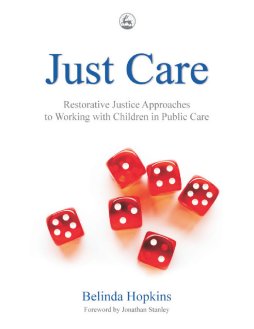
Additional Information
Book Details
Abstract
Restorative justice is an innovative approach to addressing conflict and bullying, as well as disruptive, challenging and criminal behaviour. A restorative approach in a care setting shifts the emphasis from managing and responding to anti-social behaviour to the building, nurturing and repairing of relationships, and encourages the young person to accept responsibility and put things right.
In this photocopiable resource, Belinda Hopkins identifies the practical benefits of employing the restorative approach. In extreme cases, this can mean dealing with serious incidents effectively without recourse to the police and the criminal justice system. For day-to-day interactions the approach builds on the principles of social pedagogy and 'restorative parenting', and offers a fresh look at encouraging self-regulation through the promotion of pro-social behaviour and greater involvement of the young people themselves in making choices that address everyone's needs.
Just Care is essential reading for residential care managers and staff, social workers, youth offending team managers and those with responsibility for foster care training and development.
Belinda Hopkins' transfer of emphasis from restorative justice to restorative approaches, which highlight the benefits of proactive behaviour reinforcement rather than just using it as a reactive intervention, is most welcome... Just Care is a practical guide full of activities and examples for any practitioner who wants to adopt restorative approaches with children in public care.
Children & Young People Now
There are few people who really "walk the walk" as well as "talking the talk" (and writing the words) - Belinda is one of them, and it shines through this book. And when it comes down to it, the restorative approaches and communications for children and staff she describes are not just a topic for specialists - it is good practice for all of us to follow in our Quaker Meetings and other communities.
Quakers in Criminal Justice
Belinda Hopkins is Director and Lead Trainer of Transforming Conflict, The National Centre for Restorative Justice in Youth Settings. She is author of Just Schools – A Whole School Approach to Restorative Justice, also published by Jessica Kingsley Publishers.
Table of Contents
| Section Title | Page | Action | Price |
|---|---|---|---|
| 1. INTRODUCTION 1 | |||
| 1.1. Purpose of this book 1 | |||
| 1.2. The first decade of PV pumping 1 | |||
| 2. WHEN TO USE SOLAR PUMPS 4 | |||
| 2.1. Energy requirements for water pumping 4 | |||
| 2.2. Solar energy 7 | |||
| 2.3. Typical water pumping applications 7 | |||
| 2.4. Physical and economic factors 9 | |||
| 2.5. Case Studies 12 | |||
| 3. SOLAR PUMPING TECHNOLOGY 18 | |||
| 3.1. Introduction to Photovoltaics 18 | |||
| 3.2. Photovoltaic arrays 20 | |||
| 3.3. Motors and pumps 23 | |||
| 3.4. Power conditioning 30 | |||
| 3.5. Storage and distribution 31 | |||
| 3.6. Operation and performance 35 | |||
| 4. AVAILABLE EQUIPMENT 38 | |||
| 4.1. Range 38 | |||
| 4.2. Operational specifications 40 | |||
| 4.3. System costs 40 | |||
| 4.4. Component costs 46 | |||
| 4.5. Specimen systems for typical loads 48 | |||
| 4.6. Future trends in costs 49 | |||
| 5. GENERAL FIELD EXPERIENCE 50 | |||
| 5.1. Characteristics of installations 50 | |||
| 5.2. Performance 56 | |||
| 5.3. Reliability 59 | |||
| 5.4. Non-economic factors 60 | |||
| 6. SITE AND SYSTEM EVALUATION FOR VILLAGE WATER SUPPLY 62 | |||
| 6.1. Physical system layout 64 | |||
| 6.2. Groundwater resources 64 | |||
| 6.3. The solar resource 67 | |||
| 6.4. Water requirements 69 | |||
| 6.5. Array sizing 71 | |||
| 6.6. Estimating performance 75 | |||
| 7. SITE AND SYSTEM EVALUATION FOR IRRIGATION PUMPING 79 | |||
| 7.1. Physical system layout 80 | |||
| 7.2. Crop water requirements 82 | |||
| 7.3. Array sizing 86 | |||
| 7.4. Performance and optimisation 87 | |||
| 8. PRACTICAL COST APPRAISAL 91 | |||
| 8.1. Economic evaluation 91 | |||
| 8.2. Cost appraisal of water pumping 96 | |||
| 8.3 Guidance on Costs 103 | |||
| 9. IMPLEMENTATION AND OPERATION 107 | |||
| 9.1. System selection 107 | |||
| 9.2. Procurement 108 | |||
| 9.3. Installation and operation Ill | |||
| 9.4. Maintenance 112 | |||
| 9.5. Monitoring and evaluation 112 | |||
| BIBLIOGRAPHY 114 | |||
| GLOSSARY OF TERMS 116 | |||
| APPENDICES | |||
| Appendix A: Global daily isolation maps 121 | |||
| Appendix B: Summary of manufacturers data 126 | |||
| Appendix C: List of major manufacturers and distributors 130 | |||
| Appendix D: Specimen systems for given pumping scenarios 131 | |||
| Appendix E: Breakdown of system costs by configuration 135 | |||
| Appendix F: Discount factors for life-cycle cost analyses 137 | |||
| Appendix G: Quick reference data for wind, diesel and hand pumping 139 | |||
| Appendix H: Example of a PV pump life-cycle costing 145 | |||
| Appendix I: The economics of PV pumping 148 |
